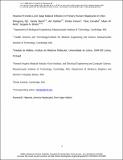| dc.contributor.author | Ng, Shengyong | |
| dc.contributor.author | March-Riera, Sandra | |
| dc.contributor.author | Galstian, Ani | |
| dc.contributor.author | Hanson, Kirsten | |
| dc.contributor.author | Carvalho, Tania | |
| dc.contributor.author | Mota, Maria M. | |
| dc.contributor.author | Bhatia, Sangeeta N | |
| dc.date.accessioned | 2013-12-13T18:41:23Z | |
| dc.date.available | 2013-12-13T18:41:23Z | |
| dc.date.issued | 2013-11 | |
| dc.date.submitted | 2013-07 | |
| dc.identifier.issn | 1754-8403 | |
| dc.identifier.issn | 1754-8411 | |
| dc.identifier.uri | http://hdl.handle.net/1721.1/82922 | |
| dc.description.abstract | Homeostasis of mammalian cell function strictly depends on balancing oxygen exposure to maintain energy metabolism without producing excessive reactive oxygen species. In vivo, cells in different tissues are exposed to a wide range of oxygen concentrations, and yet in vitro models almost exclusively expose cultured cells to higher, atmospheric oxygen levels. Existing models of liver stage malaria that utilize primary human hepatocytes typically exhibit low in vitro infection efficiencies, possibly due to missing microenvironmental support signals. One cue that may influence the infection capacity of cultured human hepatocytes is the dissolved oxygen concentration. We developed a microscale human liver platform comprised of precisely patterned primary human hepatocytes and nonparenchymal cells (MPCC) to model liver stage malaria, but the oxygen concentrations are typically higher in the in vitro liver platform than anywhere along the hepatic sinusoid. Indeed, we observed that liver stage Plasmodium parasite development in vivo correlates with hepatic sinusoidal oxygen gradients. Therefore, we hypothesized that in vitro liver stage malaria infection efficiencies may improve under hypoxia. Using the infection of MPCCs with P. berghei or P. yoelii as a model, we observed that ambient hypoxia resulted in increased survival of exo-erythrocytic forms (EEFs) in hepatocytes, and improved parasite development in a subset of surviving EEFs, based on EEF size. Further, the effective cell surface oxygen tensions (pO2) experienced by the hepatocytes, as predicted by a mathematical model, were systematically perturbed by varying culture parameters like hepatocyte density and media height, uncovering an optimal cell surface pO2 to maximize the number of mature EEFs. Initial mechanistic experiments reveal that treatment of primary human hepatocytes with the hypoxia mimetic, cobalt (II) chloride, as well as a HIF-1α activator, dimethyloxalylglycine, also enhance P. berghei infection, suggesting that the effect of hypoxia on infection is mediated in part by host-dependent HIF-1α mechanisms. | en_US |
| dc.description.sponsorship | Bill & Melinda Gates Foundation (Award 51066) | en_US |
| dc.description.sponsorship | Howard Hughes Medical Institute | en_US |
| dc.language.iso | en_US | |
| dc.publisher | Company of Biologists | en_US |
| dc.relation.isversionof | http://dx.doi.org/10.1242/dmm.013490 | en_US |
| dc.rights.uri | http://creativecommons.org/licenses/by-nc-sa/3.0/legalcode | en_US |
| dc.source | Company of Biologists | en_US |
| dc.title | Hypoxia promotes liver stage malaria infection in primary human hepatocytes in vitro | en_US |
| dc.type | Article | en_US |
| dc.identifier.citation | Ng, S., S. March, A. Galstian, K. Hanson, T. Carvalho, M. M. Mota, and S. N. Bhatia. “Hypoxia promotes liver stage malaria infection in primary human hepatocytes in vitro.” Disease Models & Mechanisms (November 28, 2013). | en_US |
| dc.contributor.department | Massachusetts Institute of Technology. Institute for Medical Engineering & Science | en_US |
| dc.contributor.department | Harvard University--MIT Division of Health Sciences and Technology | en_US |
| dc.contributor.department | Massachusetts Institute of Technology. Department of Biological Engineering | en_US |
| dc.contributor.department | Massachusetts Institute of Technology. Department of Electrical Engineering and Computer Science | en_US |
| dc.contributor.department | Koch Institute for Integrative Cancer Research at MIT | en_US |
| dc.contributor.mitauthor | Ng, Shengyong | en_US |
| dc.contributor.mitauthor | March-Riera, Sandra | en_US |
| dc.contributor.mitauthor | Galstian, Ani | en_US |
| dc.contributor.mitauthor | Bhatia, Sangeeta N. | en_US |
| dc.relation.journal | Disease Models & Mechanisms | en_US |
| dc.eprint.version | Final published version | en_US |
| dc.type.uri | http://purl.org/eprint/type/JournalArticle | en_US |
| eprint.status | http://purl.org/eprint/status/PeerReviewed | en_US |
| dspace.orderedauthors | Ng, S.; March, S.; Galstian, A.; Hanson, K.; Carvalho, T.; Mota, M. M.; Bhatia, S. N. | en_US |
| dc.identifier.orcid | https://orcid.org/0000-0002-1293-2097 | |
| dc.identifier.orcid | https://orcid.org/0000-0001-8863-7310 | |
| mit.license | PUBLISHER_CC | en_US |
| mit.metadata.status | Complete | |
